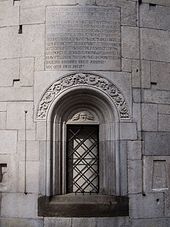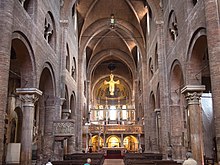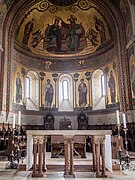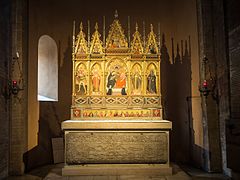Modena Cathedral
The Cathedral of Modena is a Roman Catholic church in the Romanesque style in the Italian city of Modena . It is the cathedral of the Archdiocese of Modena-Nonantola and was consecrated in 1184. The cathedral is one of the most important Romanesque buildings in Europe and recognized by UNESCO as a World Heritage Site.
history
Ancient Modena (Mutina) was a thriving Roman colony on the Via Emilia that was almost completely destroyed by invasions, earthquakes and floods after the 4th century and gradually fell into disrepair. The residents were therefore forced to leave the city and settle elsewhere (today Cittanova, a suburb of Modena). However, towards the end of the 9th century, Modena was rebuilt and fortified under Bishop Ludovicus.
The two churches built on the site of today's cathedral since the 5th century were both destroyed. In the middle of the 11th century, the first church was replaced by a larger one, but it was soon no longer big enough, so that by the end of the century people decided to build a new church.
As a result of a dispute between the papacy and empire, the then bishop Eriberto was defeated by Pope Gregory VII in 1081 because of his sympathy for King Henry IV ( walk to Canossa ) and the antipope Clement III. excommunicated . However, since the Pope could not find a candidate that the residents of Modena could accept, the diocese remained without a bishop for a few years. It was not until 1100 that Pope Urban II appointed a new bishop. At that time, however, the residents of Modena had already decided, without the participation of a bishop, to build a large new cathedral and had already started construction.
The decision made by the residents of Modena in complete independence from the imperial and ecclesiastical authorities was indicative of the striving for self-determination and freedom in Modena. The cathedral was the symbol of the right to autonomy and freedom of a community and some time later led to the establishment of a free commune (1135).
Work on today's cathedral began in 1099 under the direction of the builder Lanfranco. The first stone was laid on May 9, 1099 with the support of Mathilde von Tuszien (Mathilde von Canossa), one of the most powerful women of the 11th and 12th centuries in northern Italy. On a plaque outside the main apse, May 23, 1099 is given as the day of the founding of the new cathedral in Modena and also the name of the architect Lanfranco.
The cathedral was built by Pope Lucius III. consecrated on July 12, 1184. However, the cathedral was not completed until 1322.
The cathedral is named after the Bishop of Modena (349) and patron saint of the city: San Geminiano . His remains were solemnly transferred from his grave in the old church to the crypt of the new cathedral in 1106 in the presence of Pope Paschal II and Countess Mathilde von Tuszien .
Furthermore, Duke Ercole III is in the cathedral . d'Este buried, his tomb was created by the sculptor Giuseppe Pisani in 1808.
architecture
Modena Cathedral is considered to be one of the most important Romanesque buildings in Europe, but it also features elements from other stylistic epochs such as the Gothic and Renaissance . It consists of two parts: the church (duomo) and the bell tower (campanile). The tower is called Torre Ghirlandina and is about 86 meters high. The free-standing bell tower typical of Italy (i.e. not directly connected to the church) was started in Romanesque style in 1169 and later completed with a Gothic spire based on a design by Arrigo da Campione (14th century). The Torre Ghirlandina got its name after two garland-like marble railings in the area of the spire. The five-storey Torre Ghirlandina is the city's landmark.
Inside the tower , a copy of the painting Secchia rapita is kept in the Sala della Secchia , which is decorated with frescoes from the 15th century . The picture is reminiscent of the time when valuables belonging to the community were kept in the tower. The capitals on the 5th floor are carved in the Stanza dei Torresani .
The outer walls of the church are characterized by white marble stones, between which reddish and gray stones are mixed, which is why the appearance is uneven and varied. The reason for this is probably that materials from the ruins of the Roman buildings were used for the construction of the cathedral. This marble-clad brick facade is structured by typical Romanesque style elements such as dwarf galleries and blind arcades . The magnificent Gothic wheeled window on the side of the main portal and the two attached turrets and the two rather simple side portals were created by stonemasons from Campione . The workers from the northern Italian town near Lugano on Lake Lugano (Lago di Lugano) were involved in the construction work for generations and were able to complete the cathedral in 1322.
The facade of the cathedral has remarkable reliefs made by the sculptor Wiligelmus, a contemporary of Lanfranco. These reliefs contain portraits of prophets and patriarchs, but also biblical stories, and represent masterpieces of Romanesque sculptures. Scientists particularly point to the depiction of Adam and Eve , the original sin and the story of Noah .
The interior of the cathedral is divided into three long aisles, but has no transept , so it is not built in the typical cross shape. The altar with the golden cross hanging over it is at the end of the main nave, behind it there is an apse that was laid out in two levels. In the lower part of the apse there is the crypt , in which the bones of St. Geminiano rest in a sarcophagus secured by a glass safe. There are also several prayer benches and an altar there. Above the crypt, in the upper part of the apse, is the high choir , an arrangement typical of Romanesque churches.
Between the nave and the crypt is a marble parapet made by Anselmo da Campione , on which the Passion of Christ including the Last Supper is depicted. The pulpit comes from Arrigo da Campione and is decorated with sculptures made of terracotta .
Between 1437 and 1455 the original half-timbered beams were hidden under vaulted ceilings.
In the 18th century the central apse of the crypt was changed. Thanks to a donation, the walls could be clad with rare and precious marble. The vaults were also rebuilt and decorated with stucco and other materials. On this occasion, a new and valuable urn for the relics of the saint was also made and the altar was framed with a marble balustrade .
As further important measures, the floor was changed in the late 19th to early 20th century, the dome was removed and the church was connected to the sacristy , which was also given a new, elevated walkway in Romanesque style on this occasion .
More recently, three bronze doors have been used on the portals. However, these doors did not meet with the approval of the majority of citizens, as they were viewed as too modern and there was no harmony with the facade. After a dispute, including national art critics, the cathedral chapter finally had the bronze doors replaced by wooden doors.
From 2007 to 2014 the cathedral was extensively renovated.
Organs
There are two organs in the cathedral . On the one hand, there is a small mechanical instrument in the cathedral from 1719, which was built by Giandomenico Traeri. The organ has 5 stops (Principale 8 ′, VIII-XV, XIX, XV-XXII and XXII-XXVI on one manual) and has an attached pedal .
The main organ was built in 1934 by the organ building company Vegezzi Bossi. The instrument has 38 stops on two manuals and a pedal. The actions are electro-pneumatic.
|
|
|
||||||||||||||||||||||||||||||||||||||||||||||||||||||||||||||||||||||||||||||||
- Coupling : normal coupling, sub- and super-octave coupling
Special events
In November 1938, the publisher Angelo Fortunato Formiggini threw himself from the bell tower of the cathedral in desperation over the anti-Semitic legislation of the Italian government.
On September 8, 2007, the funeral service for the famous tenor Luciano Pavarotti took place in the Cathedral of Modena . From September 6 to 8, 2007, around 100,000 people said goodbye to Pavarotti, who was laid out in an open coffin. Archbishop Benito Cocchi also read a condolence word from Pope Benedict XVI at the funeral mass broadcast worldwide . The funeral was musically accompanied by the Choir of the City of Modena, the soprano Rajna Kabaiwanska , the flautist Andrea Griminelli and the tenor Andrea Bocelli .
Web links
- Cathedral website (ita.)
- architetturamedievale (ita.)
- Entry on the UNESCO World Heritage Center website ( English and French ).
Individual evidence
- ↑ Ilse Krumpöck: Die Bildwerke im Heeresgeschichtliches Museum , Vienna 2004, p. 134 f.
- ↑ Thomas Steinfeld : The old new shelter. The Romanesque cathedral of Modena has been carefully restored . In: Süddeutsche Zeitung of February 20, 2015, p. 12.
- ↑ Information on the organs ( Memento from September 7, 2013 in the Internet Archive )
Coordinates: 44 ° 38 ′ 46.4 " N , 10 ° 55 ′ 32.6" E










